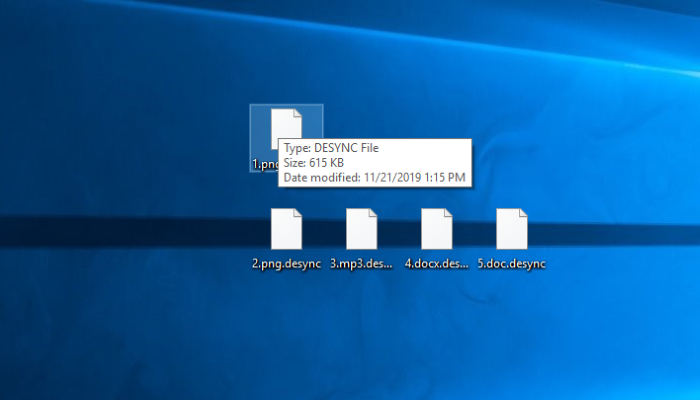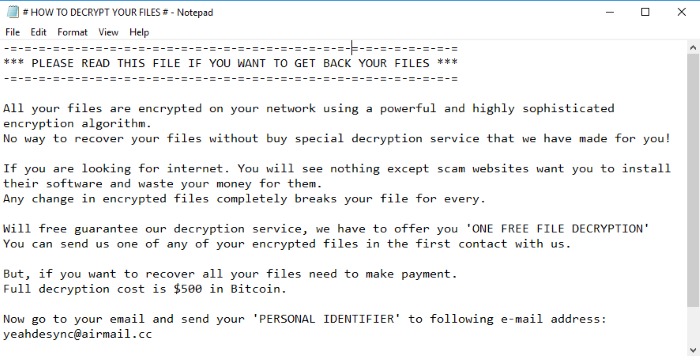DESYNC ransomware encryption process.
DESYNC ransomware is a fresh version of the virus, that was active in the January of this year. Fully it can be described as the file-encryption ransomware virus. DESYNC is a new family of viruses and it’s a unique one, but it has a lot in common with other families, such as STOP(DJVU) ransomware family:MBED, PEET, GROD, MOSK, TOEC, NAKW, Derp, COOT, Nols, Werd, Ndarod, Leto, Bora and RECO; and DHARMA file-encryption ransomware family the members of which are: KHARMA, newer version of MONEY, Money, Oo7 and CASH. All these viruses have a common feature – they attack the devices unpredictably. It’s so as the code of the virus is injected into a harmless file and it executes, once someone decides to open such a file. Usually the infected files are distributed by the means of email attachments, but such the file can be found nearly everywhere. These files can hardly be differed from the harmless ones and it’s the main feature of these viruses. We recommend you to avoid downloading of any free software from the questionable websites and if your device is already infected with this virus, don’t try to remove DESYNC ransomware encryption by yourself. The files can be easily corrupted permanently, if you do so.

The encryption process in the case of infection with DESYNC ransomware is executed in the same way. It’s the two-step background process, that begins with the scanning. DESYNC ransomware can modify only definite file formats, that are probably the most valuable information on the hard drive. These files are documents and a great variety of media files. The choice of the appropriate files is that, as the ecnryption of all diles would take a great amount of time. When the files are found, the virus begins to modify their structures. As the result, it changes their extensions to .desync ones. Then DESYNC ransomware creates the ransom note, that is called # HOW TO DECRYPT YOUR FILES #.txt. This note aims at the forcing the owner of the infeted device to pay hacker for the decryption services, that they provide. The words of hackers cannot be trusted. They are criminals and promises are simple sounds for them. you don’t have any real guarantee, that they will help you. Moreover, there is a great risk, that they will stop all contacts once they receive the payment. Don’t take this risk! In the case, if you really need to remove DESYNC ransomware and decrypt .desync files, we’ve prepared the guide, that can be useful!

# HOW TO DECRYPT YOUR FILES #.txt
-=-=-=-=-=-=-=-=-=-=-=-=-=-=-=-=-=-=-=-=-=-=-=-=-=-=-=-=-=-=-=-=
*** PLEASE READ THIS FILE IF YOU WANT TO GET BACK YOUR FILES ***
-=-=-=-=-=-=-=-=-=-=-=-=-=-=-=-=-=-=-=-=-=-=-=-=-=-=-=-=-=-=-=-=
All your files are encrypted on your network using a powerful and highly sophisticated encryption algorithm.
No way to recover your files without buy special decryption service that we have made for you!
If you are looking for internet. You will see nothing except scam websites want you to install their software and waste your money for them.
Any change in encrypted files completely breaks your file for every.
Will free guarantee our decryption service, we have to offer you 'ONE FREE FILE DECRYPTION'
You can send us one of any of your encrypted files in the first contact with us.
But, if you want to recover all your files need to make payment.
Full decryption cost is $500 in Bitcoin.
Now go to your email and send your 'PERSONAL IDENTIFIER' to following e-mail address:
yeahdesync@airmail.ccArticle’s Guide
- How to remove DESYNC Ransomware from your computer
- How to remove DESYNC Ransomware encryption from your files
- Data Recovery
- Automated decryption tools
- Windows Previous Versions
How to remove DESYNC Ransomware from your computer?
We strongly recommend you to use a powerful anti-malware program that has this threat in its database. It will mitigate the risks of the wrong installation, and will remove DESYNC from your computer with all of its leftovers and register files.
Solution for Windows users: our choice is Norton 360 . Norton 360 scans your computer and detects various threats like DESYNC, then removes it with all of the related malicious files, folders and registry keys.
If you are Mac user, we advise you to use Combo Cleaner.
How to decrypt .desync files?
Once you’ve removed the virus, you are probably thinking how to decrypt .desync files. Let’s take a look at possible ways of decrypting your data.
Recover data with Data Recovery

- Download and install Data Recovery
- Select drives and folders with your files, then click Scan.
- Choose all the files in a folder, then press on Restore button.
- Manage export location.
The download is an evaluation version for recovering files. To unlock all features and tools, purchase is required ($49.99-299). By clicking the button you agree to EULA and Privacy Policy. Downloading will start automatically.
Restore data with automated decryption tools
Unfortunately, due to the novelty of DESYNC ransomware, there are no available automatic decryptors for this encryptor yet. Still, there is no need to invest in the malicious scheme by paying a ransom. You are able to recover files manually.
You can try to use one of these methods in order to restore your encrypted data manually.
Remove DESYNC encryption with Windows Previous Versions
This feature is working on Windows Vista (not Home version), Windows 7 and later versions. Windows keeps copies of files and folders which you can use to restore data on your computer. In order to restore data from Windows Backup, take the following steps:
- Open My Computer and search for the folders you want to restore;
- Right-click on the folder and choose Restore previous versions option;
- The option will show you the list of all the previous copies of the folder;
- Select restore date and the option you need: Open, Copy and Restore.


